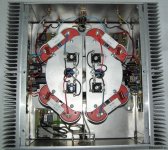hello to all and happy holidays I have finished assembling my JLH 2003 with the new mj15003 transistors how much should the quiescent current be adjusted to? a member of the forum says 3.8 A that seems like a lot to me what do you think thank you

Divide half the supply voltage by the speaker impedance and multiply the result by 0.7 (approximately).
You want the output to be voltage limited/clip so that means the peak current output needs to be the peak voltage (supply/2) divided by the load impedance. So single ended class-A amps have to idle at that current but push-pull class-A amps only need half as much idle current because the pull-up/down is not part, not half of the load. But usually, you want a bit more because the distortion will be better if you stay away from current clipping, hence OldDIY suggests 0.7 and not 0.5. 3.8 Amps seems a bit excessive but any "JLH" amp is not about technical correctness.
The class A amplifier heats up very much - 3 times more energy goes into the heat continuously than the output. Large heat sinks (more than 2000 cm2) or kilograms of aluminum are needed.
Big, heavy, hot, expensive...

Big, heavy, hot, expensive...
Attachments
Last edited:
A JLH amplifier usually refers to the original 1969 design, as published then in Wireless World magazine. There were later, more elaborate versions, most with the original 10-15W or so rating and no more than 1.5A bias current each channel, for a single supply of 30V and nominal 8 ohm speaker loads. The suggested bias current for various operating conditions is shown in table 3 of the original article. Obviously, if you alter the design or power supplies substantially, you will need to compensate for it within the ratings of the actual components used and maintain sufficient bias current if you wish to have full class A operation up to the available peak power capacity.
The specs of the design in the article show what it's capable of, and the according ratings and appropriate bias levels. You can read it all in the archived "Class A Amplifier Site" articles section now hosted by Rod Elliott at his ESP website. See the articles and information index at: sound-au.com
The specs of the design in the article show what it's capable of, and the according ratings and appropriate bias levels. You can read it all in the archived "Class A Amplifier Site" articles section now hosted by Rod Elliott at his ESP website. See the articles and information index at: sound-au.com
Last edited:
- Home
- Amplifiers
- Solid State
- JlH 2003 courant de repos
